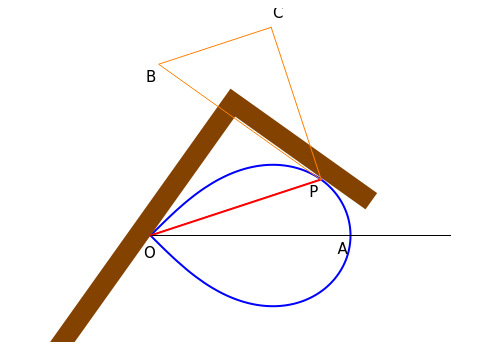Trisecting an Angle Using a Lemniscate
Trisecting an Angle Using a Lemniscate
The angle to trisect, say , is between the longer leg of the carpenter's square (the brown "L" shape) and the polar axis . Translate the carpenter's square so that it touches the curve at the point . The angle between the radius vector and the polar axis is one-third of the given angle .
α
OA
P
AOP
OP
OA
α
For any curve in polar coordinates, the tangent of the angle between the tangent and radial line (the angle between vectors and ) at the point is . The lemniscate has the polar equation , and the derivative with respect to is , so . So . Since is obtuse, .
β
OP
PB
(r,θ)
tan(β)=r/r'
r=
cos(2θ)
θ
r'=
-sin(2θ)
cos(2θ)
r/r'==-cot(2θ)
cos(2θ
-sin(2θ)
cos(2θ)
tan(β)=-cot(2θ)=-tan(π/2-2θ)=tan(2θ-π/2)
β
β=2θ+π/2
So , and the angle between the tangent and the normal to the radius vector is . But this angle is equal to the angle between the larger leg of the carpenter's square and the radius vector , because these angles have orthogonal legs. So , .
∠OPB=π-β=π/2-2θ
BPC
PB
PC
OP
2θ
BPC
OP
α-θ=2θ
α=3θ
